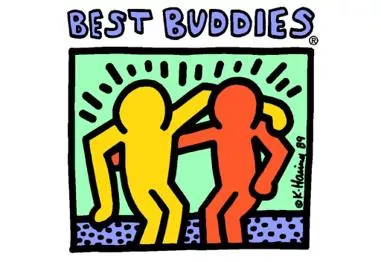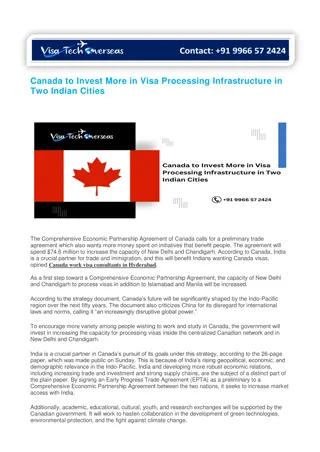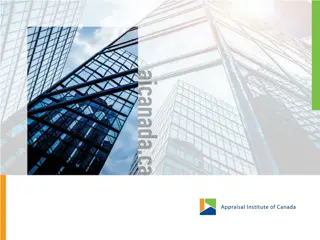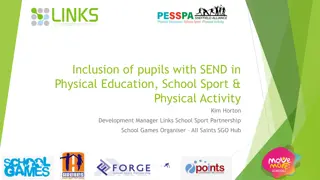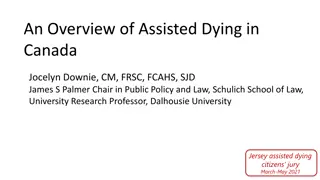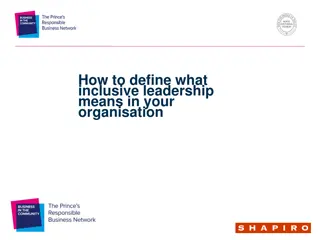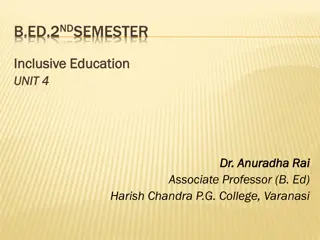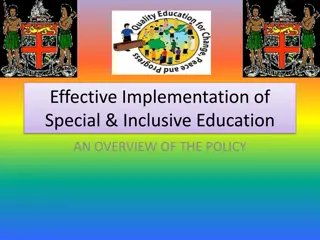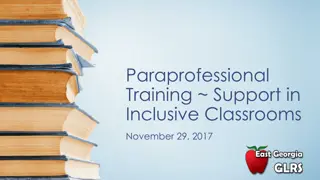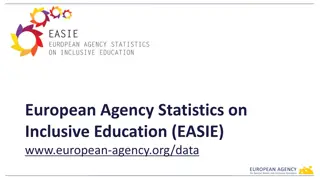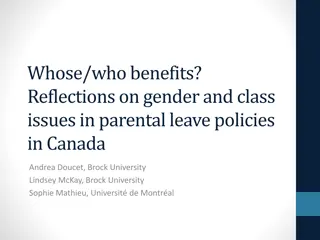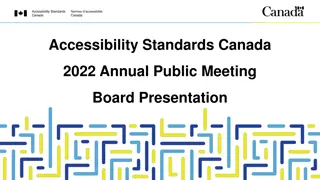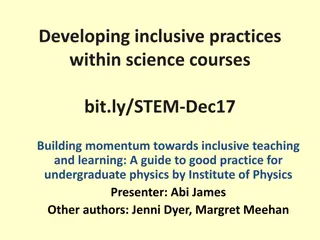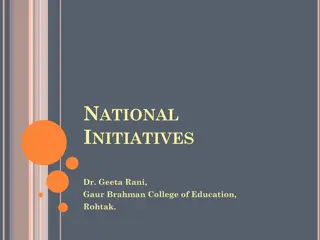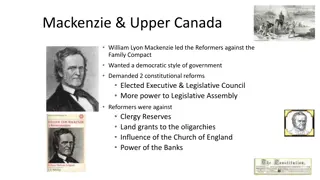Inclusive and Special Education: Impact and Evolution in Canada
Explore the journey of inclusive and special education in Canada, from historical milestones to current challenges. Delve into the concept of inclusive education and its impact on students with disabilities, supported by a comprehensive curriculum. Discover the evolving role of educators and the strides made towards creating a more inclusive learning environment.
Download Presentation

Please find below an Image/Link to download the presentation.
The content on the website is provided AS IS for your information and personal use only. It may not be sold, licensed, or shared on other websites without obtaining consent from the author. Download presentation by click this link. If you encounter any issues during the download, it is possible that the publisher has removed the file from their server.
E N D
Presentation Transcript
Inclusive Education/ Special Education STUDENTS WITH DISABILITIES
Guiding Questions What is inclusive education? How is it funded? How have the lives of people with disabilities been impacted by society in Canada and in the world? What is our role as middle years teachers in terms of people with disabilities? What kind of supports are out there to help people with disabilities, as well as teachers?
Curriculum Connection PA 6.3 Explore examples and explain how people, such as ethnic minority groups, the disabled, youth, and the elderly, may be affected by injustice or abuses of power. PA8.1 Contemplate the implications of Canadian citizenship on the life of Canadians. Social studies education can be defined as the study of people and their relationships with their social, physical, and technological environments (Saskatchewan Curriculum)
Inclusive education means that all students attend and are welcomed by their neighborhood schools in age-appropriate, regular classes and are supported to learn, contribute and participate in all aspects of the life of the school. (involves all learning abilities) Special Education: is the practice of educating students in a way that addresses their individual differences.
Historical Timeline Information from the BC teachers federation (2018): 1890: First recorded legislation provides for the education of handicapped children . Deaf children are sent to the Institution for the Deaf and Dumb in Winnipeg, Manitoba. 1915: Vancouver School Board establishes classes for deaf and blind children. Originally known as the Provincial Oral School, it later becomes Jericho Hill School. Early 1950s: Government takes no responsibility for the education of children with developmental disabilities. Medical and education experts advise families to send children with special needs to residential institutions. 1955: The provincial government introduces funding for programs for handicapped children as part of the basic grant to school districts. 1956: UBC holds the first special education teacher training and in 1959 becomes the first Canadian university to appoint a Professor of Special Education. March 1970: Ministry of Education (MOE) creates Special Education Division to assist school districts to develop programs. 1980s: MOE develops policy and procedure for including children and youth with special needs in regular classrooms 1989-1990: School Act revised in response to Royal Commission on Education, entitling all school-aged children to a full educational program, not separated from other students, and in their neighbourhood school 2002: The government strips teachers' collective agreements, resulting in larger class sizes, fewer specialist teachers, and the dramatic reduction of supports for students with special needs. November 2016: Supreme Court of Canada renders final decision in the 16-year court battle restoring class-size and composition language and consequently, more support for students.
The Education Act The Education Act mandates all school boards to provide special education programs and/or services for students with special education needs. (first passed 1975)
Who/ What? There are five categories and twelve definitions of exceptionalities (from the Ministry of Education Ontario, 2018) Behaviour behaviour issues Intellectual giftedness, mild intellectual disability, developmental disability Communication autism, deaf and hard-of- hearing, language impairment, speech impairment, learning disability Physical physical disability, blind and low vision Multiple multiple exceptionalities
Funding: The Special Education Grant The Special Education Grant is made up of six allocations (from the Ministry of Education Ontario, 2018): 1. Special Education Per Pupil Amount 2. Differentiated Special Education Needs Amount 3. Special Equipment Amount 4. Special Incidence Portion 5. Care, Treatment, Custody and Correctional Amount (Formerly Facilities Amount) 6. Behavior Expertise Amount
Funding - determined by the Identification Placement and Review Committee (IPRC) (funding is) - funding is often based on the number of students and not the overall need - the number of students with a need is determined by those who have IEPs (Ministry of Education, 2018)
- Indigenous communities (do not receive enough funding) (Phillips, 2010) Who does this create disadvantages for? - lower socio-economic background families - children who do not have involved parents - communities where supports are not available
Pull in vs Pull Out Method (Current) Information from Amanda Morin, 2019) PULL OUT PULL IN -specialists works closely with child in the general education classroom - specialists work closely with students outside of the general classroom - requires collaboration between teachers, specialists and special education teacher - the general classroom teacher is rarely involved when child is pulled out - services are provided through the IEP
PROS/ CONS OF PULL IN PROS/CONS PULL OUT METHOD Pros: Pros: - more direct instruction that s tailored to their unique needs. - Students miss less instructional timeThere s less disruption to a student s daily schedule. - fewer distractions for students outside the general education classroom. There s more direct interaction between all of a student s providers. - Students have more personalized interaction with providers, which helps students build trust and gives them extra emotional support Students get to learn and practice skills in the general education classroom, which gives them more opportunities. - Teachers and specialists don t have to spend as much time grounding a lesson for the entire classroom. Cons: Cons - fewer opportunities for students to receive tailored and explicit instruction to help them gain skills they need to keep up with the curriculum. - There s less opportunity for specialists and teachers to collaborate and to determine whether pull-out instruction is helping students access the general education curriculum. - Students may feel different or uncomfortable because they have to leave the general classroom for services. Co-planning instruction and working around differences in teaching styles can create obstacles for teachers. - more scheduling difficulties - often more distractions for students
Parent Comments https://www.cbc.ca/news/canada/special-ed-iep-support-1.3751522 - children are more benefitted when parents are involved in the process - not every parent has the time or the resources to be involved - parents feel there are benefits from both methods, but it depends on the abilities of their child - communication is key, the struggles are often to do with lack of communication
Teacher Comments - one of the biggest challenges with Inclusive education is teacher willingness and preparedness (lack of resources) - do not feel feel that Canadian universities do enough to teach them how to adequately prepare, as a result they struggle
Teaching Resources file:///Users/ashleywilmot/Downloads/Race_Privilege_Lesson_Plan_FINAL.pdf : :Lesson Plan https://www.pbs.org/newshour/extra/lessons-plans/lesson-plan-build-empathy-with-disabilities- stories/: Lesson Plan/ Videos https://media.specialolympics.org/resources/community-building/youth-and-school/unified- champion-schools/Mini-Lesson-Understanding-Disability.pdf: Lesson Plans for younger students, but also provides resources about what special education is https://www.mrsdscorner.com/special-ed-teacher-life/: Day in the life of a special education teacher https://bookriot.com/2017/10/19/love-letter-bookstore/: list of 5 great books that involve characters with disabilities O Shae the octopus by Brandi Buble: O Shae was born with 10 arms. He faces bullying, but ultimately comes to realize the greatness of being unique.
Conclusion - inclusive education is different than I thought (not special education) - we need better education on the classroom management strategies to deal with needs - we need to provide our students with more resources to ensure they understand what inclusive education is and why it is important - research alone cannot say all the answers, need experience
Questions What changes can be made to the system to make it more inclusive? What changes can be made so funding is allocated in a more beneficial way? Are children being over diagnosed? Will my opinions change after I have been a teacher for a long time? Any other questions? Do you believe in the pull in/ pull out method that is in current practice?
Resources The Ministry of Education Ontario. (2018) A Guide to the special education grant. Retrieved from: http://www.edu.gov.on.ca/eng/funding/1819/special-education-grant-2018-2019-en.pdf The Minnesota Governor s Council on Developmental Disabilities. (2007). History of Education. Retrieved from: www.mncdd.org/pipm/education/history_overview.html Morin, A (N.d). The difference between push-in and pull-out services. Understood. Retrieved from: https://www.understood.org/en/school-learning/special-services/special-education-basics/the-difference-between-push-in-and-pull-out- services O Neil, E (2018). From Institution to Inclusion. British Columbia Teacher s Federation. Retrieved from: https://www.bctf.ca/publications/NewsmagArticle.aspx?id=51159 Phillips, R (2010). Special Education in Schools in Canada: Policies of Cost Containment. Alberta Journal of Educational Research. Retrieved from: https://search-proquest-com.libproxy.uregina.ca/docview/762783739/61F5F0B42EB94871PQ/4?accountid=13480 Prarie Rose School Division (2019). What is an Individualized Education Plan (IEP)?. Retrieved from: http://www.prsdmb.ca/programs/student-services/individualized-education-plan/ Riva, N. (2016). A lot of kids needs are not being met. Lots of labels, lack of resources for students with special needs Sterland, A (2013) How Stories and reading can help teach children about diversity. The Guardian. Retrieved from: https://www.theguardian.com/social-care-network/2014/feb/03/stories-reading-teach-children-disability University of Washington (2017). What is the difference between an IEP and 504 Plan? Do it: University of Washington. Retrieved from: https://www.washington.edu/doit/what-difference-between-iep-and-504-plan

 undefined
undefined


 undefined
undefined




